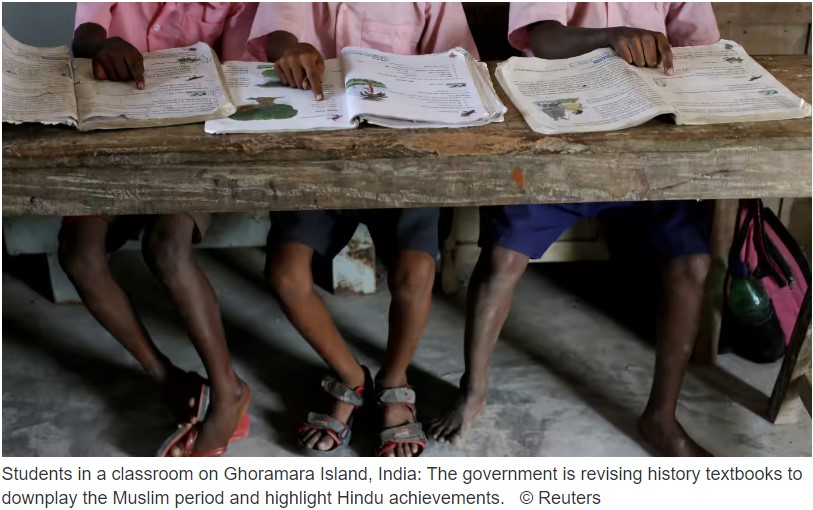GDP, personal income stagnated during historical era of Hindu rule.
India’s ruling Bhartiya Janata Party has long garnished its Hindu nationalist agenda with the claim that its homeland was the world’s richest region during a glorious millennium of historical Hindu rule.
According to this view, India’s conquest by Muslim invaders in the 11th century and by British troops in the 18th century converted a sone ki chidiya, or golden bird, into an enslaved pauper.
The BJP thus aims to return India to golden Hindu prosperity.
During British rule, colonial textbooks carried chapters on the blessings of the British Raj. They claimed that a poor, backward country had been uplifted by Britain’s superior civilization.
Authoritative estimates of the economic history of different parts of the world had to wait for the work of scholars like the late British historian Angus Maddison in the late 20th century.
The BJP and other Indian parties love to cite Maddison, since he trashed inflated colonial claims. In his 2007 book, “Contours of the World Economy 1–2030 AD: Essays in Macroeconomic History,” Maddison estimated that India accounted for 32% of world GDP under Hindu rule in 1 AD. Its share declined to 24% under Muslim rule and to just 4% by the end of British rule.
The BJP has lambasted the Indian National Congress party, which ruled India for most of the years between independence in 1947 and the BJP’s recapture of power in 2014, for neglecting the glories of the period of Hindu rule in history textbooks. The government is now revising textbooks to downplay the Muslim period and highlight Hindu achievements.
But the BJP is cherry‐picking from Maddison’s work to create a false historical narrative of a once‐rich country impoverished by foreign invaders. A fuller view of Maddison’s work is less flattering.
India represented 33.2% of the world’s population in the year 1 AD, the highest share of any nation, according to Maddison’s analysis. Since that was slightly more than India’s GDP share, it indicates the nation’s output per person was a bit below the world average.
India’s annual per capita income then was just $450. Italy, under the Roman Empire, was almost twice as rich.
According to Maddison’s estimates, India’s GDP stagnated at a level of $33.75 billion over the next millennia of Hindu rule. Per capita income also recorded zero growth as the population remained steady at around 75 million.
The trend observed in most of the world was almost as bad. Drought, disease and war meant that merely staying alive was a challenge.
In sum, India’s era of Hindu rule was one of stark poverty, economic stagnation and high mortality. Nothing golden about it.
Under Muslim rule, roughly between 1000 and 1700, India’s annual GDP almost tripled to $90.75 billion. Mortality fell substantially, enabling the population to grow from 75 million to 165 million. This substantially offset GDP growth, so per capita income grew by barely a quarter, from $450 to $550.
These trends intensified in the British period. Between 1700 and 1950, India’s GDP rose to $222.22 billion and its population to 359 million. Annual per capita income rose marginally to $619.
Clearly, British colonial claims of having uplifted a backward India were vastly exaggerated. As Maddison noted, enormous sums were transferred from India to its colonial ruler. Had these funds been invested in India itself, they could have greatly increased Indian prosperity.
However, India did not get poorer in per capita income terms in the British era, as alleged by the BJP. India’s share of world GDP plummeted mainly because incomes in the West soared after the industrial revolution.
Britain’s per capita income rose from $400 in 1 AD to $1,706 in 1700. It climbed further during the period of India’s colonization to reach $6,939 by 1950.
Incomes then skyrocketed in the post‐colonial era to hit $21,210 by 2003. Clearly, Britain’s prosperity was due largely to factors besides colonialism.
Economic growth finally took off in India after it became independent. After almost 2,000 years of negligible growth, per capita income soared to $2,140 by 2003. Mortality fell sharply, so the population rose to 1.05 billion despite the spread of contraception.
India’s golden era, if it can be called that, is today, not in the distant past.
Maddison said that his estimates for earlier periods were approximations requiring further research. But he is widely acknowledged as a great historian, and his trend estimates are credible even if no figure can be considered exact.
Having cited Maddison repeatedly on the crash in India’s world GDP share, the BJP can hardly contest his other, less flattering findings.
But GDP is not everything. Despite high poverty, ancient Indians — like ancient Greeks, Egyptians and Persians — achieved major feats in architecture, literature, philosophy and mathematics. Great universities flourished at Nalanda and Taxila.
But in terms of economic performance, the golden bird was not around. The BJP is wrong to create a fictitious history of a rich Hindu India later impoverished by foreign invaders. This has become a bogus reason to sneer at and mistreat Muslim and Christian minorities. Bad history is being used to promote the politics of hate.
This article was originally published by Nikkei Asia on July 23, 2023.


